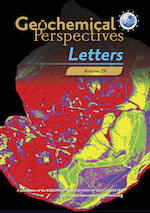Dissolved molybdenum asymptotes in sulfidic waters
Affiliations | Corresponding Author | Cite as | Funding information- Share this article





-
Article views:114Cumulative count of HTML views and PDF downloads.
- Download Citation
- Rights & Permissions
top
Abstract
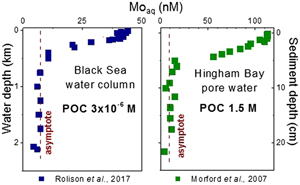
Figures and Tables
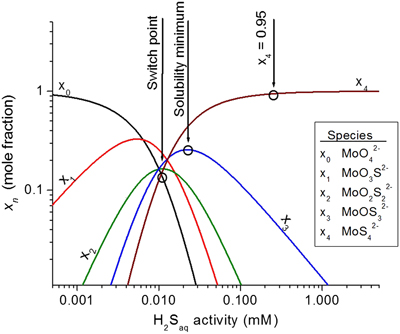 Figure 1 Mole fractions of aqueous MoO4−nSn2– species versus the activity of H2Saq, which is the non-ionised fraction of total dissolved sulfide. Circles mark three special points: where MoO42− = MoS42− (switch point); where x3 reaches its maximum (corresponding to the solubility minimum); and where x4 ≥ 0.95, signifying effective completion of Moaq thiolation. | 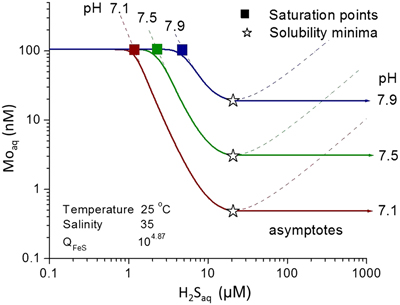 Figure 2 Effect of rising H2Saq on FeMoS4 solubility (dashed curves) in seawater (initial Moaq = 105 nM) assuming saturation with FeSnano, a material more soluble and reactive than mackinawite (Wolthers et al., 2005; Matamoros-Veloza et al., 2018). At FeMoS4 saturation points (squares), the solubility drops below ambient Moaq,0 and precipitation begins. Eventually, solubility minima (stars) are reached. Actual Moaq follows the heavy curves because an irreversible redox transformation blocks redissolution of precipitated Mo. Based on Equation 2 in Helz and Vorlicek (2019). | 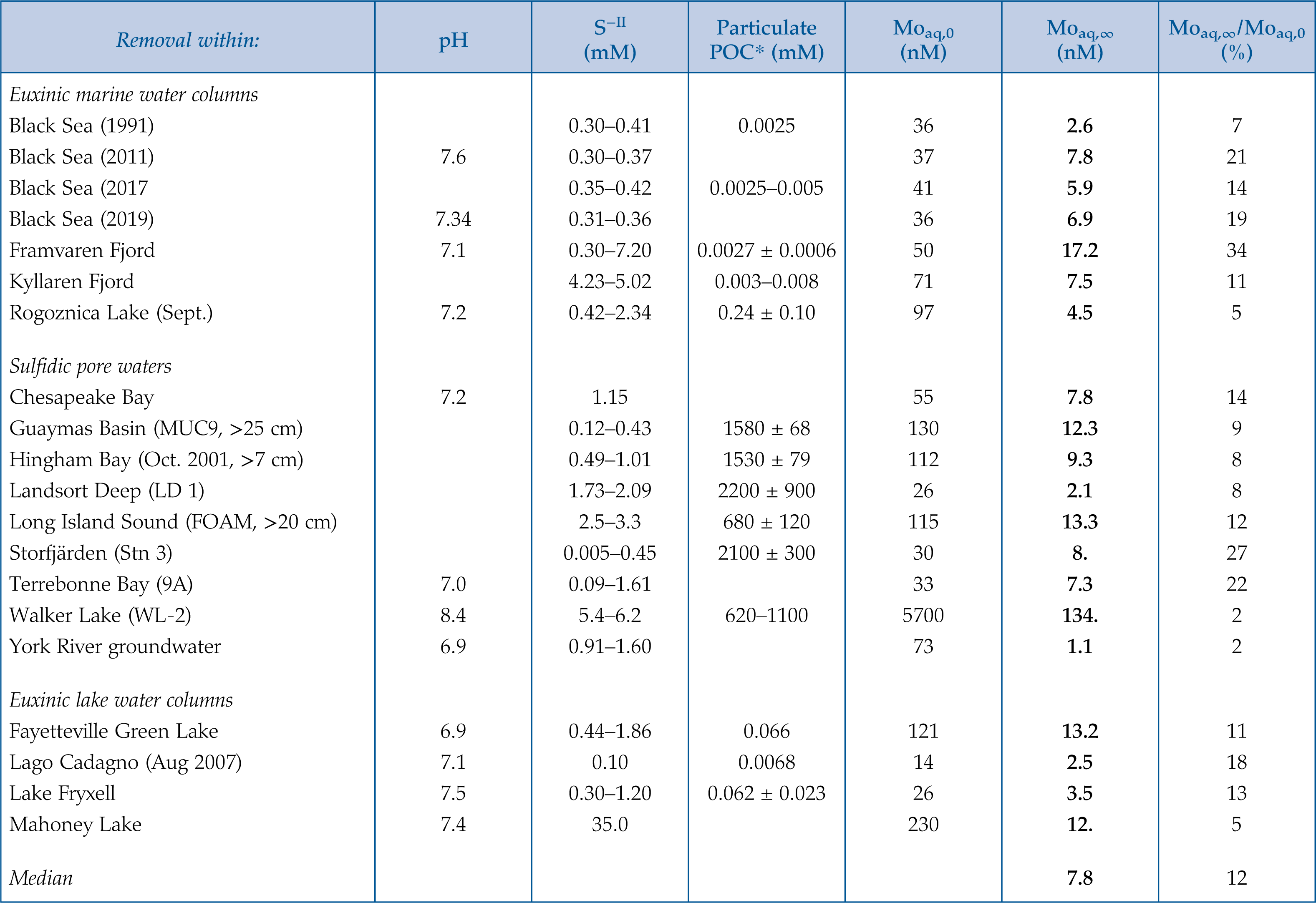 Table 1 Limits to the degree of dissolved Mo removal from sulfidic environments (Moaq,0 = dissolved Mo at onset of sulfidic conditions; Moaq,∞ = dissolved Mo at asymptote; S–II is total dissolved sulfide range over depths where Moaq,∞ ≈ constant). For sources of data, see Note I in the Supplementary Information. | 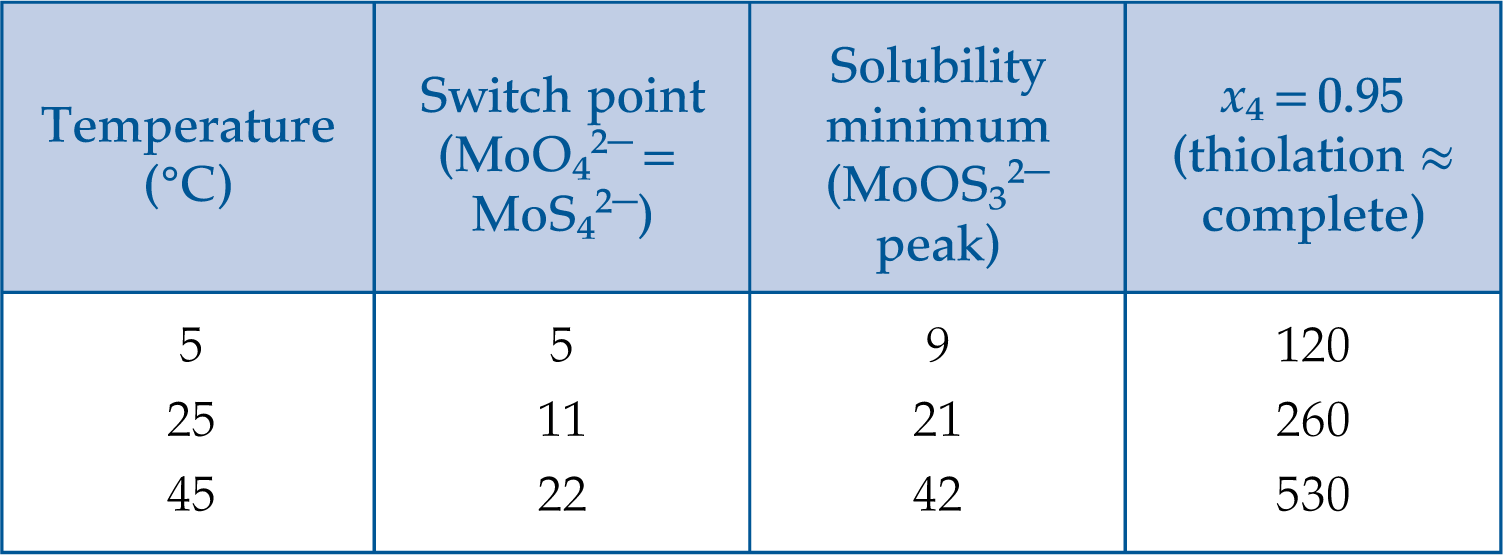 Table 2 Concentrations of H2Saq (μM) at selected temperatures and degrees of MoO42– thiolation (ionic strength = 0). |
| Figure 1 | Figure 2 | Table 1 | Table 2 |
top
Existence and Characteristics of Asymptotes
In the oxic ocean, dissolved Mo (Moaq) is almost entirely MoO42–. Particulate Mo (Mos) constitutes <0.001 % of ΣMo, except near terrigenous or hydrothermal particle sources (Ho et al., 2018
Ho, P., Lee, J.-M., Heller, M.I., Lam, P.J., Shiller, A.M. (2018) The distributions of dissolved and particulate Mo and V along the U.S. GEOTRACES East Pacific zonal transect (GP16): The roles of oxides and biogenic particles in their distribution in the oxygen deficient zone and the hydrothermal plume. Marine Chemistry 201, 242–255.
). However, where H2S or HS– replaces dissolved O2, MoO42– becomes thiolated, and Moaq concentrations fall sharply toward asymptotes while Mos in contiguous sediments rises. The resulting elevated Mos is interpreted as signifying sulfide’s presence during sedimentation.A compilation in Table 1 shows that the span of Moaq asymptote concentrations in diverse sulfidic environments is remarkably narrow. Entries in Table 1 meet the criteria that (a) a water column or pore water becomes sulfidic at depth, (b) Moaq drops markedly (by >50 %) below where sulfide first appears, and (c) Moaq ultimately stabilises at asymptotes (designated Moaq,∞) that are distinctly above analytical detection limits. The median asymptote value is 7.8 nM, and four fifths of the values fall in the range 2.5–13.3 nM. Asymptotes are prevalent in nature, but not universal; beneath some lakes and coastal embayments, pore water Moaq concentrations fall to minima before rising at greater depths (see Morford et al., 2009
Morford, J.L., Martin, W.R., François, R., Carney, C.M. (2009) A model for uranium, rhenium and molybdenum diagenesis in marine sediments based on results from coastal locations. Geochimica et Cosmochimica Acta 73, 2938–2960.
; Dahl et al., 2010Dahl, T.W., Anbar, A.D., Gordon, G.W., Rosing, M.T., Frei, R., Canfield, D.E. (2010) The behavior of molybdenum and its isotopes across the chemocline and in the sediments of sulfidic Lake Cadagno, Switzerland. Geochimica et Cosmochimica Acta 74, 144–163.
; Havig et al., 2015Havig, J.R., McCormick, M.L., Hamilton, T.L., Kump, L.R. (2015) The behavior of biologically important trace elements across the oxic/euxinic transition of meromictic Fayettville Green Lake, New York, USA. Geochimica et Cosmochimica Acta 165, 389–406.
; Sulu-Gambari et al., 2017Sulu-Gambari, R., Roepert, A., Jilbert, T., Hagens, M., Meysman, F.J.R., Slomp, C.P. (2017) Molybdenum dynamics in sediments of a seasonally-hypoxic coastal marine basin. Chemical Geology 466, 627–640.
). The reason for this atypical pattern is unclear; infiltration of groundwater from surrounding uplands or very slow reductive dissolution of Mo-rich detrital phases sourced from nearby land may be contributing factors.Table 1 Limits to the degree of dissolved Mo removal from sulfidic environments (Moaq,0 = dissolved Mo at onset of sulfidic conditions; Moaq,∞ = dissolved Mo at asymptote; S–II is total dissolved sulfide range over depths where Moaq,∞ ≈ constant). For sources of data, see Note I in the Supplementary Information.
| Removal within: | pH | S−II (mM) | Particulate POC* (mM) | Moaq,0 (nM) | Moaq,∞ (nM) | Moaq,∞/Moaq,0 (%) |
| Euxinic marine water columns | ||||||
| Black Sea (1991) | 0.30–0.41 | 0.0025 | 36 | 2.6 | 7 | |
| Black Sea (2011) | 7.6 | 0.30–0.37 | 37 | 7.8 | 21 | |
| Black Sea (2017 | 0.35–0.42 | 0.0025–0.005 | 41 | 5.9 | 14 | |
| Black Sea (2019) | 7.34 | 0.31–0.36 | 36 | 6.9 | 19 | |
| Framvaren Fjord | 7.1 | 0.30–7.20 | 0.0027 ± 0.0006 | 50 | 17.2 | 34 |
| Kyllaren Fjord | 4.23–5.02 | 0.003–0.008 | 71 | 7.5 | 11 | |
| Rogoznica Lake (Sept.) | 7.2 | 0.42–2.34 | 0.24 ± 0.10 | 97 | 4.5 | 5 |
| Sulfidic pore waters | ||||||
| Chesapeake Bay | 7.2 | 1.15 | 55 | 7.8 | 14 | |
| Guaymas Basin (MUC9, >25 cm) | 0.12–0.43 | 1580 ± 68 | 130 | 12.3 | 9 | |
| Hingham Bay (Oct. 2001, >7 cm) | 0.49–1.01 | 1530 ± 79 | 112 | 9.3 | 8 | |
| Landsort Deep (LD 1) | 1.73–2.09 | 2200 ± 900 | 26 | 2.1 | 8 | |
| Long Island Sound (FOAM, >20 cm) | 2.5–3.3 | 680 ± 120 | 115 | 13.3 | 12 | |
| Storfjärden (Stn 3) | 0.005–0.45 | 2100 ± 300 | 30 | 8. | 27 | |
| Terrebonne Bay (9A) | 7.0 | 0.09–1.61 | 33 | 7.3 | 22 | |
| Walker Lake (WL-2) | 8.4 | 5.4–6.2 | 620–1100 | 5700 | 134. | 2 |
| York River groundwater | 6.9 | 0.91–1.60 | 73 | 1.1 | 2 | |
| Euxinic lake water columns | ||||||
| Fayetteville Green Lake | 6.9 | 0.44–1.86 | 0.066 | 121 | 13.2 | 11 |
| Lago Cadagno (Aug 2007) | 7.1 | 0.10 | 0.0068 | 14 | 2.5 | 18 |
| Lake Fryxell | 7.5 | 0.30–1.20 | 0.062 ± 0.023 | 26 | 3.5 | 13 |
| Mahoney Lake | 7.4 | 35.0 | 230 | 12. | 5 | |
| Median | 7.8 | 12 |
*Particulate POC concentrations are expressed per litre of solution. Where more than three POC measurements are available, mean ± standard deviation is reported; otherwise, the range is given.
Of particular importance in Table 1 is the million-fold range of particulate organic carbon (POC) concentrations (expressed per unit volume of solution). For instance, during diagenesis, solutes in Hingham Bay’s sulfidic pore waters are in diffusive contact with ∼1.5 moles POC/L (calculated for sediments with 3.2 % total organic carbon, porosity = 0.8, and 2.5 g/cm3 dry density; see Note II in the Supplementary Information). In contrast, measured POC concentrations in the Black Sea’s sulfidic deep waters are 2.5–5.0 × 10–6 mol/L (Kaiser et al., 2017
Kaiser, D., Konovalov, S., Schulz-Bull, D.E., Waniek, J.J. (2017) Organic matter along longitudinal and vertical gradients in the Black Sea. Deep Sea Research Part I 129, 22–31.
). Despite the 106 difference, similar Moaq,∞ asymptotes occur in both places. It could be argued that a mismatch in renewal rates of water and organic particles in the Black Sea makes this apparent POC disparity misleading. Below 1 km depth, the Black Sea’s water is renewed every ∼103 yr whereas its POC is renewed every ∼101 yr (estimated from the POC accumulation rate in underlying sediments; Arthur et al., 1994Arthur, M.A., Dean, W.E., Neff, E.D., Hay, B.J., King, J., Jones, G. (1994) Varve calibrated records of carbonate and organic carbon accumulation over the last 2000 years in the Black Sea. Global Biogeochemical Cycles 8, 195–217.
). Thus, deep water is cumulatively exposed to 102 times more POC than is present instantaneously. On this basis, the Black Sea’s POC concentration is only 104, rather than 106, times smaller than Hingham Bay’s, but the disparity is still huge.Asymptotes are likewise insensitive to final S–II concentrations (Table 1). For example, the maximum S–II concentration in the Black Sea is 0.4 mM and that in Kyllaren Fjord is 5.0 mM, but both reach similar Moaq,∞ asymptotes. The extreme Moaq,∞ asymptotes in Table 1 (i.e. Walker Lake, 130 nM, and York River, 1.1 nM) mirror pH extremes, hinting that pH explains some of the asymptote variation, though the data are insufficient to establish this for certain. Any explanation for Moaq removal from sulfidic natural waters must account for why asymptotes are insensitive to ΣS–II (= H2Saq + HS–) and POC, but possibly sensitive to pH.
top
Organic Scavenging
The principal argument for organic scavenging rests on correlations commonly, but not universally, observed between Mos and organic matter in sedimentary rocks. As reviewed by Helz and Vorlicek (2019)
Helz, G.R., Vorlicek, T.P. (2019) Precipitation of molybdenum from euxinic waters and the role of organic matter. Chemical Geology 509, 178–193.
, no satisfactory molecular mechanism to explain Moaq scavenging by organic matter under natural conditions has yet been found, and evidence is also lacking for significant biological scavenging. If organic scavenging exists, it is likely to be an abiotic process that can be described by a Langmuir isotherm as:Eq. 1

where Mos is non-lithogenic Mo adsorbed onto particulate organic carbon (mol Mos/L), xs the mole fraction of a specific binding site (mol sites/mol C), POC the particulate organic carbon concentration (mol/L), Kn’ the conditional binding constant (L/mol) for the nth MoO4−nSn2– ion, and xn the mole fraction of the nth MoO4−nSn2– ion in Moaq (see Fig. 1).

Figure 1 Mole fractions of aqueous MoO4−nSn2– species versus the activity of H2Saq, which is the non-ionised fraction of total dissolved sulfide. Circles mark three special points: where MoO42− = MoS42− (switch point); where x3 reaches its maximum (corresponding to the solubility minimum); and where x4 ≥ 0.95, signifying effective completion of Moaq thiolation.
For simplicity, Equation 1 assumes only one adsorbing MoO4−nSn2– species and only one binding site. Multiple species or sites could be included by adding more terms. At the pH and Moaq concentrations of most sulfidic natural waters, the second term in the denominator is negligible, making isotherms linear. In the linear case, Equation 1 is tantamount to the empirical Mos/POC vs. Moaq relationship found for euxinic basin sediments by Algeo and Lyons (2006
Algeo, T.J., Lyons, T.W. (2006) Mo-total organic carbon covariation in modern marine environments: Implication for analysis of paleoredox and paleohydrographic conditions. Paleooceanography and Paleoclimatology 21, PA1016.
; see their Fig. 8a).What does the linear form imply about aqueous asymptotes? Mass balance requires that:
Eq. 2

where Moaq,0 is the initial total dissolved Mo and Moaq is the same during adsorption progress. Rearranging:
Eq. 3

In diverse euxinic basins and sulfidic pore waters, asymptotes fix the ratio on the left hand side of this equation at a median value of 12 % (seventh column, Table 1). This requires that in nature the denominator’s second term has a restricted range centred near 8. Given the 106 range of its POC factor, this requirement cannot possibly be met. Additionally, at any specific site, the ratio on the left is roughly constant through the asymptote zone, requiring that the second term in the denominator is also constant. However, H2Saq varies through asymptote zones (third column, Table 1), and xn values strongly vary with H2Saq (Fig. 1). Only at high H2Saq concentrations, where x4 becomes sulfide independent, can Equation 3 describe constant asymptotes at a constant POC concentration. (In this case, x4 replaces xn in Equation 3, implying that MoS42– is the only adsorbed species.) However, H2Saq concentrations high enough for x4 to approach constancy exceed the concentrations at which Moaq asymptotes commence in nature. For example, the Moaq asymptote in the Black Sea commences at H2Saq ≈ 50 μM (where ΣS−II ≈ 300 μM), whereas Figure 1 shows that H2Saq must be much higher, near 200 μM, for x4 to come within 5 % of its ultimate limiting value. Equation 3, which describes organic scavenging, therefore cannot explain Moaq asymptotes.
top
FeMoS4 Precipitation
Earlier workers rejected the possibility of Mo precipitation by sulfide. Emerson and Huested (1991)
Emerson, S.R., Huested, S.S. (1991) Ocean anoxia and the concentrations of molybdenum and vanadium in seawater. Marine Chemistry 34, 177–196.
pointed out that, unlike sulfide-precipitated metals, Moaq fails to decline continuously with increasing ΣS–II. In agreement, Algeo and Lyons (2006)Algeo, T.J., Lyons, T.W. (2006) Mo-total organic carbon covariation in modern marine environments: Implication for analysis of paleoredox and paleohydrographic conditions. Paleooceanography and Paleoclimatology 21, PA1016.
noted that Cariaco Basin sediments accumulate higher Mos concentrations than Black Sea sediments, even though Cariaco waters contain less sulfide.Nevertheless, Vorlicek et al. (2018)
Vorlicek, T.P., Helz, G.R., Chappaz, A., Vue, P., Vezina, A., Hunter, W. (2018) Molybdenum burial mechanism in sulfidic sediments: iron-sulfide pathway. ACS Earth and Space Chemistry 2, 565–576.
found a colloidal precipitate, FeMoS4, with a solubility that could explain Moaq asymptotes in the Black Sea. At equilibrium with this precipitate (see derivation in Note III, Supplementary Information):Eq. 4

where γMoS4 is the activity coefficient of MoS42– and QFeS = {Fe2+}{H2Saq}/{H+}2. Except for the x3 term, the factors on the righthand side of Equation 4 display limited variability in asymptote zones. QFeS values are usually constrained by saturation with iron monosulfide phases and pH is constrained mainly by strong ΣCO2/ΣALK buffering. On the other hand, x3 varies considerably, passing through a maximum with increasing H2Saq activity (Fig. 1). In Table 2, values of H2Saq at x3 maxima have been estimated over a moderate temperature range by the isocoulombic extrapolation method (Gu et al., 1994
Gu, Y., Gammons, C.H., Bloom, M.S. (1994) A one-term extrapolation method for estimating equilibrium constants of aqueous reactions at elevated temperatures. Geochimica et Cosmochimica Acta 58, 3545–3560.
). Equation 4 requires that at x3 maxima, Moaq solubility reaches minima; this is illustrated by dashed curves in Figure 2. However, aging transforms FeMoVIS4 to an inert MoIV phase, preventing Mo redissolution when the solubility curves turn upward beyond the minima. As a result, the FeMoS4 precipitation mechanism predicts that Moaq becomes fixed at asymptotes that are unresponsive to further H2Saq increases. The asymptotes are also independent of POC, despite the 106 range in nature, because organic matter has no role in the precipitation and aging reactions, except as fuel for biological sulfate reduction (Helz and Vorlicek, 2019Helz, G.R., Vorlicek, T.P. (2019) Precipitation of molybdenum from euxinic waters and the role of organic matter. Chemical Geology 509, 178–193.
). Thus FeMoS4 precipitation meets the requirements listed above for a mechanism that can explain asymptotes.Table 2 Concentrations of H2Saq (μM) at selected temperatures and degrees of MoO42– thiolation (ionic strength = 0).
| Temperature (°C) | Switch point (MoO42– = MoS42–) | Solubility minimum (MoOS32– peak) | x4 = 0.95 (thiolation ≈ complete) |
| 5 | 5 | 9 | 120 |
| 25 | 11 | 21 | 260 |
| 45 | 22 | 42 | 530 |

Figure 2 Effect of rising H2Saq on FeMoS4 solubility (dashed curves) in seawater (initial Moaq = 105 nM) assuming saturation with FeSnano, a material more soluble and reactive than mackinawite (Wolthers et al., 2005
Wolthers, M., Charlet, L., van der Linde, P.R., Rickard, D., van der Weijden, C.H. (2005) Surface chemistry of disordered mackinawite (FeS). Geochimica et Cosmochimica Acta 69, 3469–3481.
; Matamoros-Veloza et al., 2018Matamoros-Veloza, A., Cespedes, O., Johnson, B.R.G., Stawski, T.M., Terranova, U., de Leeuw, N.H., Benning, L.G. (2018) A highly reactive precursor in the iron sulfide system. Nature Communications 9, 3125.
). At FeMoS4 saturation points (squares), the solubility drops below ambient Moaq,0 and precipitation begins. Eventually, solubility minima (stars) are reached. Actual Moaq follows the heavy curves because an irreversible redox transformation blocks redissolution of precipitated Mo. Based on Equation 2 in Helz and Vorlicek (2019)Helz, G.R., Vorlicek, T.P. (2019) Precipitation of molybdenum from euxinic waters and the role of organic matter. Chemical Geology 509, 178–193.
.top
Implications
Several implications of interest in the palaeoproxy field arise from this result.
Asymptotes block quantitative removal of Moaq from sulfidic waters, leaving dissolved residuals that ultimately escape the sulfidic environment. In the median case in Table 1, the residual (Moaq,∞/Moaq,0) is only 12 % but can be much higher. This finding undermines the common assumption that marine euxinic basins preserve the δ98Mo signatures of global seawater because of quantitative precipitation. Residuals will be greatest in waters of lower salinity, where Moaq,0 will be lower, and in waters of higher pH, where Moaq,∞ will be higher. Both situations generate higher Moaq,∞/Moaq,0 ratios at asymptotes, permitting larger fractions of incoming Moaq to escape deposition.
The idea that Mos/POC ratios in sedimentary rocks can be used to estimate Moaq in ancient basins (Algeo and Lyons, 2006
Algeo, T.J., Lyons, T.W. (2006) Mo-total organic carbon covariation in modern marine environments: Implication for analysis of paleoredox and paleohydrographic conditions. Paleooceanography and Paleoclimatology 21, PA1016.
, and others) relies on the relationship in Equation 1, which is premised on the dominance of POC scavenging. Without scavenging, such Moaq estimates are ungrounded.Table 1 shows that Moaq asymptotes in the pH range of modern environments all exceed 1 nM, the level thought to curb nitrogen fixation by Mo-nitrogenase (Glass et al., 2010
Glass, J.B., Wolfe-Simon, F., Elser, J.J., Anbar, A.D. (2010) Molybdenum-nitrogen co-limitation in freshwater and coastal heterocystous cyanobacteria. Limnology and Oceanography 55, 667–676.
). Therefore, past global euxinia would not have shut down Mo-nitrogenase activity, creating marine nitrogen crises, unless accompanied by substantial acidification, which lowers Moaq,∞ (Fig. 2).Can FeMoS4 precipitation explain why the Black Sea produces lower sedimentary Mos despite higher bottom water H2Saq concentrations compared to the Cariaco Basin? Consistent with the organic scavenging mechanism (Eq. 1), Algeo and Lyons (2006)
Algeo, T.J., Lyons, T.W. (2006) Mo-total organic carbon covariation in modern marine environments: Implication for analysis of paleoredox and paleohydrographic conditions. Paleooceanography and Paleoclimatology 21, PA1016.
regarded bottom water Moaq concentration, which is lower in the Black Sea, as the controlling variable. The Black Sea’s lower bottom water Moaq concentration, and consequent lower sediment Mos concentration, were attributed to a Moaq supply restriction at the narrow Bosporus. This explanation is probably incorrect. The Bosporus distributes 4–5 times more Moaq into the Black Sea than its sediments accumulate (Piper and Calvert, 2009Piper, D.Z., Calvert, S.E. (2009 A marine biogeochemical perspective on black shale deposition. Earth-Science Reviews 95, 63–96.
), and the excess returns through the Bosporus. On the other hand, the Bosporus restricts the Black Sea’s river water throughput. Copious river inflow lowers surface salinity and intensifies density stratification, thus inhibiting introduction of oxidants into deep waters. Consequently, ΣS–II accumulates sufficiently for the FeMoS4 saturation point to ascend into the water column, causing Moaq drawdown there. Cariaco’s better ventilation, attested by its shorter water residence time, suppresses ΣS–II despite opposition from a greater POC rain rate. This confines Cariaco’s saturation point to pore waters. Calculations based on ΣS–II and pH data suggest that the Black Sea’s saturation point is near 150 m depth in the water column, whereas Cariaco’s is located a few mm below the sediment–water interface (Helz and Vorlicek, 2019Helz, G.R., Vorlicek, T.P. (2019) Precipitation of molybdenum from euxinic waters and the role of organic matter. Chemical Geology 509, 178–193.
). Therefore, Cariaco’s bottom waters are pre-asymptote, whereas the Black Sea’s are syn-asymptote. Cariaco’s sediments accumulate more Mos by diffusion because of the very sharp, pre- to syn-asymptote Moaq gradient across the sediment–water interface.To summarise, the narrow range of Moaq,∞ values that form in sulfidic water columns and pore waters characterised by enormous differences in POC concentrations preclude adsorption to organic matter as an important Mo fixation process in nature. In contrast, FeMoS4 precipitation, which depends on the thermodynamic activities of H+, MoS42–, and FeS rather than their concentrations, readily explains why Moaq asymptotes are independent of final sulfide and POC concentrations.
Editor: Liane G. Benning
top
References
Algeo, T.J., Lyons, T.W. (2006) Mo-total organic carbon covariation in modern marine environments: Implication for analysis of paleoredox and paleohydrographic conditions. Paleooceanography and Paleoclimatology 21, PA1016.
 Show in context
Show in context Moaq relationship found for euxinic basin sediments by Algeo and Lyons (2006; see their Fig. 8a).
View in article
In agreement, Algeo and Lyons (2006) noted that Cariaco Basin sediments accumulate higher Mos concentrations than Black Sea sediments, even though Cariaco waters contain less sulfide.
View in article
The idea that Mos/POC ratios in sedimentary rocks can be used to estimate Moaq in ancient basins (Algeo and Lyons, 2006, and others) relies on the relationship in Equation 1, which is premised on the dominance of POC scavenging. Without scavenging, such Moaq estimates are ungrounded.
View in article
Can FeMoS4 precipitation explain why the Black Sea produces lower sedimentary Mos despite higher bottom water H2Saq concentrations compared to the Cariaco Basin? Consistent with the organic scavenging mechanism (Eq. 1), Algeo and Lyons (2006) regarded bottom water Moaq concentration, which is lower in the Black Sea, as the controlling variable.
View in article
Arthur, M.A., Dean, W.E., Neff, E.D., Hay, B.J., King, J., Jones, G. (1994) Varve calibrated records of carbonate and organic carbon accumulation over the last 2000 years in the Black Sea. Global Biogeochemical Cycles 8, 195–217.
 Show in context
Show in context Below 1 km depth, the Black Sea’s water is renewed every ∼103 yr whereas its POC is renewed every ∼101 yr (estimated from the POC accumulation rate in underlying sediments; Arthur et al., 1994).
View in article
Dahl, T.W., Anbar, A.D., Gordon, G.W., Rosing, M.T., Frei, R., Canfield, D.E. (2010) The behavior of molybdenum and its isotopes across the chemocline and in the sediments of sulfidic Lake Cadagno, Switzerland. Geochimica et Cosmochimica Acta 74, 144–163.
 Show in context
Show in context Asymptotes are prevalent in nature, but not universal; beneath some lakes and coastal embayments, pore water Moaq concentrations fall to minima before rising at greater depths (see Morford et al., 2009; Dahl et al., 2010; Havig et al., 2015; Sulu-Gambari et al., 2017).
View in article
Emerson, S.R., Huested, S.S. (1991) Ocean anoxia and the concentrations of molybdenum and vanadium in seawater. Marine Chemistry 34, 177–196.
 Show in context
Show in context Emerson and Huested (1991) pointed out that, unlike sulfide-precipitated metals, Moaq fails to decline continuously with increasing ΣS–II.
View in article
Glass, J.B., Wolfe-Simon, F., Elser, J.J., Anbar, A.D. (2010) Molybdenum-nitrogen co-limitation in freshwater and coastal heterocystous cyanobacteria. Limnology and Oceanography 55, 667–676.
 Show in context
Show in context Table 1 shows that Moaq asymptotes in the pH range of modern environments all exceed 1 nM, the level thought to curb nitrogen fixation by Mo-nitrogenase (Glass et al., 2010).
View in article
Gu, Y., Gammons, C.H., Bloom, M.S. (1994) A one-term extrapolation method for estimating equilibrium constants of aqueous reactions at elevated temperatures. Geochimica et Cosmochimica Acta 58, 3545–3560.
 Show in context
Show in context In Table 2, values of H2Saq at x3 maxima have been estimated over a moderate temperature range by the isocoulombic extrapolation method (Gu et al., 1994).
View in article
Havig, J.R., McCormick, M.L., Hamilton, T.L., Kump, L.R. (2015) The behavior of biologically important trace elements across the oxic/euxinic transition of meromictic Fayettville Green Lake, New York, USA. Geochimica et Cosmochimica Acta 165, 389–406.
 Show in context
Show in context Asymptotes are prevalent in nature, but not universal; beneath some lakes and coastal embayments, pore water Moaq concentrations fall to minima before rising at greater depths (see Morford et al., 2009; Dahl et al., 2010; Havig et al., 2015; Sulu-Gambari et al., 2017).
View in article
Helz, G.R., Vorlicek, T.P. (2019) Precipitation of molybdenum from euxinic waters and the role of organic matter. Chemical Geology 509, 178–193.
 Show in context
Show in context As reviewed by Helz and Vorlicek (2019), no satisfactory molecular mechanism to explain Moaq scavenging by organic matter under natural conditions has yet been found, and evidence is also lacking for significant biological scavenging.
View in article
The asymptotes are also independent of POC, despite the 106 range in nature, because organic matter has no role in the precipitation and aging reactions, except as fuel for biological sulfate reduction (Helz and Vorlicek, 2019).
View in article
Based on Equation 2 in Helz and Vorlicek (2019).
View in article
Calculations based on ΣS–II and pH data suggest that the Black Sea’s saturation point is near 150 m depth in the water column, whereas Cariaco’s is located a few mm below the sediment–water interface (Helz and Vorlicek, 2019).
View in article
Ho, P., Lee, J.-M., Heller, M.I., Lam, P.J., Shiller, A.M. (2018) The distributions of dissolved and particulate Mo and V along the U.S. GEOTRACES East Pacific zonal transect (GP16): The roles of oxides and biogenic particles in their distribution in the oxygen deficient zone and the hydrothermal plume. Marine Chemistry 201, 242–255.
 Show in context
Show in context Particulate Mo (Mos) constitutes <0.001 % of ΣMo, except near terrigenous or hydrothermal particle sources (Ho et al., 2018).
View in article
Kaiser, D., Konovalov, S., Schulz-Bull, D.E., Waniek, J.J. (2017) Organic matter along longitudinal and vertical gradients in the Black Sea. Deep Sea Research Part I 129, 22–31.
 Show in context
Show in context In contrast, measured POC concentrations in the Black Sea’s sulfidic deep waters are 2.5–5.0 × 10–6 mol/L (Kaiser et al., 2017).
View in article
Matamoros-Veloza, A., Cespedes, O., Johnson, B.R.G., Stawski, T.M., Terranova, U., de Leeuw, N.H., Benning, L.G. (2018) A highly reactive precursor in the iron sulfide system. Nature Communications 9, 3125.
 Show in context
Show in context Effect of rising H2Saq on FeMoS4 solubility (dashed curves) in seawater (initial Moaq = 105 nM) assuming saturation with FeSnano, a material more soluble and reactive than mackinawite (Wolthers et al., 2005; Matamoros-Veloza et al., 2018).
View in article
Morford, J.L., Martin, W.R., Kalnejais, L.H., François, R., Bopthner, M., Karle, I.-M. (2007) Insights on geochemical cycling of U, Re and Mo from seasonal sampling in Boston Harbor, Massachusetts, USA. Geochimica et Cosmochimica Acta 71, 895–915.
 Show in context
Show in context Graphical Abstract.
View in article
Morford, J.L., Martin, W.R., François, R., Carney, C.M. (2009) A model for uranium, rhenium and molybdenum diagenesis in marine sediments based on results from coastal locations. Geochimica et Cosmochimica Acta 73, 2938–2960.
 Show in context
Show in context Asymptotes are prevalent in nature, but not universal; beneath some lakes and coastal embayments, pore water Moaq concentrations fall to minima before rising at greater depths (see Morford et al., 2009; Dahl et al., 2010; Havig et al., 2015; Sulu-Gambari et al., 2017).
View in article
Piper, D.Z., Calvert, S.E. (2009) A marine biogeochemical perspective on black shale deposition. Earth-Science Reviews 95, 63–96.
 Show in context
Show in context This explanation is probably incorrect. The Bosporus distributes 4–5 times more Moaq into the Black Sea than its sediments accumulate (Piper and Calvert, 2009), and the excess returns through the Bosporus.
View in article
Rolison, J.M., Stirling, C.H., Middag, R., Rijkenberg, M.J.A. (2017) Uranium stable isotope fractionation in the Black Sea: Modern calibration of the 238U/235U paleo-redox proxy. Geochimica et Cosmochimica Acta 203, 69–88.
 Show in context
Show in context Graphical Abstract.
View in article
Sulu-Gambari, R., Roepert, A., Jilbert, T., Hagens, M., Meysman, F.J.R., Slomp, C.P. (2017) Molybdenum dynamics in sediments of a seasonally-hypoxic coastal marine basin. Chemical Geology 466, 627–640.
 Show in context
Show in context Asymptotes are prevalent in nature, but not universal; beneath some lakes and coastal embayments, pore water Moaq concentrations fall to minima before rising at greater depths (see Morford et al., 2009; Dahl et al., 2010; Havig et al., 2015; Sulu-Gambari et al., 2017).
View in article
Vorlicek, T.P., Helz, G.R., Chappaz, A., Vue, P., Vezina, A., Hunter, W. (2018) Molybdenum burial mechanism in sulfidic sediments: iron-sulfide pathway. ACS Earth and Space Chemistry 2, 565–576.
 Show in context
Show in context Nevertheless, Vorlicek et al. (2018) found a colloidal precipitate, FeMoS4, with a solubility that could explain Moaq asymptotes in the Black Sea.
View in article
Wolthers, M., Charlet, L., van der Linde, P.R., Rickard, D., van der Weijden, C.H. (2005) Surface chemistry of disordered mackinawite (FeS). Geochimica et Cosmochimica Acta 69, 3469–3481.
 Show in context
Show in context Effect of rising H2Saq on FeMoS4 solubility (dashed curves) in seawater (initial Moaq = 105 nM) assuming saturation with FeSnano, a material more soluble and reactive than mackinawite (Wolthers et al., 2005; Matamoros-Veloza et al., 2018).
View in article
top
Supplementary Information
The Supplementary Information includes:
Download the Supplementary Information (PDF).
Figures
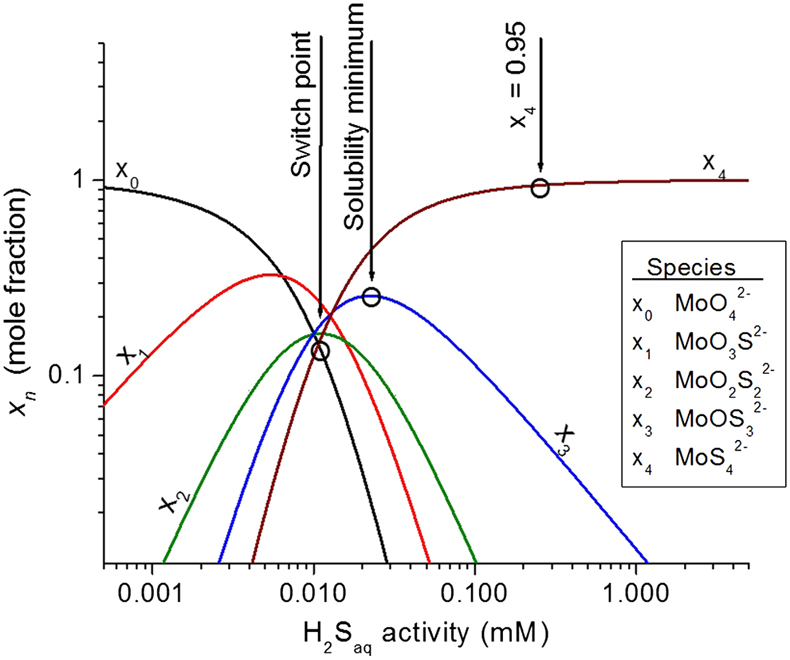
Figure 1 Mole fractions of aqueous MoO4−nSn2– species versus the activity of H2Saq, which is the non-ionised fraction of total dissolved sulfide. Circles mark three special points: where MoO42− = MoS42− (switch point); where x3 reaches its maximum (corresponding to the solubility minimum); and where x4 ≥ 0.95, signifying effective completion of Moaq thiolation.
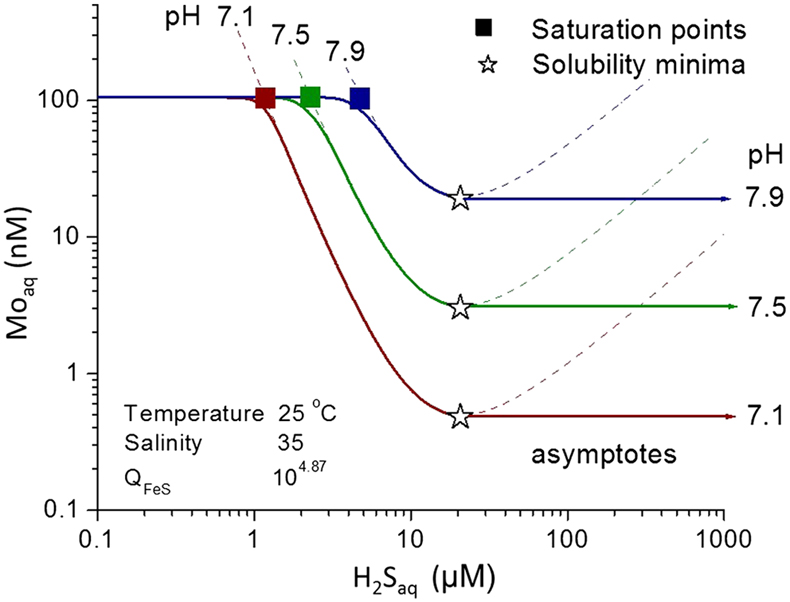
Figure 2 Effect of rising H2Saq on FeMoS4 solubility (dashed curves) in seawater (initial Moaq = 105 nM) assuming saturation with FeSnano, a material more soluble and reactive than mackinawite (Wolthers et al., 2005
Wolthers, M., Charlet, L., van der Linde, P.R., Rickard, D., van der Weijden, C.H. (2005) Surface chemistry of disordered mackinawite (FeS). Geochimica et Cosmochimica Acta 69, 3469–3481.
; Matamoros-Veloza et al., 2018Matamoros-Veloza, A., Cespedes, O., Johnson, B.R.G., Stawski, T.M., Terranova, U., de Leeuw, N.H., Benning, L.G. (2018) A highly reactive precursor in the iron sulfide system. Nature Communications 9, 3125.
). At FeMoS4 saturation points (squares), the solubility drops below ambient Moaq,0 and precipitation begins. Eventually, solubility minima (stars) are reached. Actual Moaq follows the heavy curves because an irreversible redox transformation blocks redissolution of precipitated Mo. Based on Equation 2 in Helz and Vorlicek (2019)Helz, G.R., Vorlicek, T.P. (2019) Precipitation of molybdenum from euxinic waters and the role of organic matter. Chemical Geology 509, 178–193.
.

